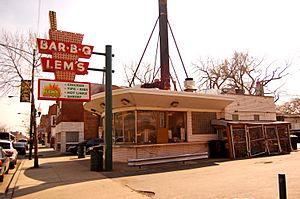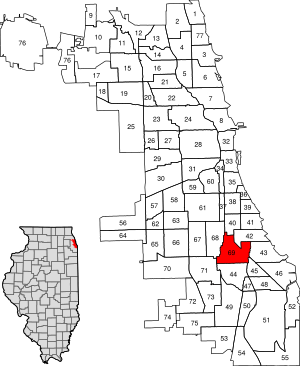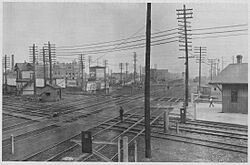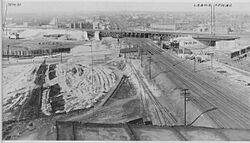Greater Grand Crossing, Chicago facts for kids
Quick facts for kids
Greater Grand Crossing
|
|
|---|---|
| Community Area 69—Greater Grand Crossing | |

Lem's Bar-B-Q restaurant on Grand Crossing's 75th Street business district.
|
|

Location within the city of Chicago
|
|
| Country | United States |
| State | Illinois |
| County | Cook |
| City | Chicago |
| Neighborhoods |
List
Grand Crossing
Greater Grand Crossing Park Manor Winneconna Parkway |
| Area | |
| • Total | 3.56 sq mi (9.22 km2) |
| Population
(2020)
|
|
| • Total | 31,471 |
| • Density | 8,841/sq mi (3,413.3/km2) |
| Demographics (2015) | |
| • Black | 96.07% |
| • White | 1.44% |
| • Hispanic | 1.11% |
| • Asian | 0.01% |
| • Other | 1.36% |
| Time zone | UTC-6 (CST) |
| • Summer (DST) | UTC-5 (CDT) |
| ZIP Codes |
parts of 60619, 60620, 60621 and 60637
|
| Median income | $26,515 |
| Source: U.S. Census, Record Information Services | |
Greater Grand Crossing is one of the 77 community areas in Chicago, Illinois. It is found on the city's South Side. This area has a long history, especially linked to railroads.
Contents
History of Grand Crossing
How Grand Crossing Got Its Name
The name "Grand Crossing" comes from a big event in 1853. Two railroad companies, the Lake Shore and Michigan Southern Railway and the Illinois Central Railroad, had a major disagreement. This argument was about building tracks across each other's lines. It led to a serious train crash that sadly killed 18 people.
The crash happened because Roswell B. Mason (who later became mayor of Chicago) built tracks for the Illinois Central across another company's tracks without permission. Because this crossing was so unsafe, trains had to stop completely there. This led to businesses growing around the area to serve the railroad workers.
Grand Crossing in the 1800s
The area was developed by Paul Cornell in the 1870s. He also developed Hyde Park, Chicago. The dangerous rail crossing wasn't made safer until 1912, when the tracks were separated.
Greater Grand Crossing was once a railroad suburb. It was made up of five smaller neighborhoods. These neighborhoods were developed by different groups of people. Grand Crossing and Brookline had many German immigrant workers. Essex had English, Irish, and Scottish immigrants who worked on the railroads. Brookdale was settled by people born in Chicago who worked in building and railroads. Park Manor, the last to develop, had residents mostly from the east coast of the United States.
Grand Crossing in the 1900s
At the start of the 1900s, parts of Greater Grand Crossing changed. Like other Chicago neighborhoods, open spaces and farms became areas filled with bungalow homes.
Population Changes in Grand Crossing
By the 1930s, Swedish and Italian people joined the railroad workers living in the neighborhood. Over the next 20 years, African Americans started moving into the area. They came from the crowded "Black Belt" neighborhoods. Around this time, many White residents began to move out of Grand Crossing.
During the 1950s, the Black population in the neighborhood grew a lot. It went from 6% to 86%.
According to information from 2014-2018, there were about 30,805 people and 12,230 homes in Greater Grand Crossing. Most residents, about 96.2%, were African American. About 1.1% were White, and 1.5% were from other backgrounds. About 1.2% of the population was Hispanic or Latino.
The population included many young people. About 32.4% were under 19 years old. The median age was 35.2 years.
| Historical population | |||
|---|---|---|---|
| Census | Pop. | %± | |
| 1930 | 60,007 | — | |
| 1940 | 61,554 | 2.6% | |
| 1950 | 61,753 | 0.3% | |
| 1960 | 63,169 | 2.3% | |
| 1970 | 54,414 | −13.9% | |
| 1980 | 45,218 | −16.9% | |
| 1990 | 38,644 | −14.5% | |
| 2000 | 38,619 | −0.1% | |
| 2010 | 37,465 | −3.0% | |
| 2020 | 31,471 | −16.0% | |
Getting Around Grand Crossing
The CTA Red Line train runs 24 hours a day, 7 days a week. It has stops at 69th Street and 79th Street in Grand Crossing. Also, the Metra Electric train line serves the area. It stops at the 75th Street station. This station is located at the famous railroad crossing that gave the neighborhood its name.
Famous People from Grand Crossing
Many notable people have lived in Greater Grand Crossing:
- Dayvon "King Von" Bennett (1994–2020) was a rapper and songwriter. He lived in Parkway Gardens.
- Gwendolyn Brooks (1917–2000) was a famous poet, author, and teacher. She won the Pulitzer Prize for Poetry in 1950. She lived on South Evans Avenue for many years.
- Al Capone (1899–1947) bought a home on South Prairie Avenue in 1923. He later moved to Cicero, Illinois.
- Gary Comer (1927–2006) was a businessman and kind giver. He founded the company Land's End. He grew up in Grand Crossing.
- Robert Cooley (born 1943) was a lawyer and author. He wrote the book "When Corruption Was King". He grew up at 74th & Vernon.
- Shani Davis (born 1982) was the first African American athlete to win a gold medal in an individual event at the Olympic Winter Games. He lived in Greater Grand Crossing until he was six.
- Wilton Daniel Gregory (born 1947) is a leader in the Catholic Church. He is the first African-American cardinal. He grew up on West 72nd Street.
- Albert "Sunnyland Slim" Luandrew (1906–1995) was a blues pianist. He helped make Chicago a center for blues music. He lived on East 69th Street in the 1970s.
- Michelle Obama (born 1964) was the 51st First Lady of the United States. She lived in the Parkway Garden Homes as a child. Her family moved when she was two years old.
- Leroy Orange (born 1950) was a resident of East 75th Street.
- Craig Robinson (born 1962) is a college basketball coach and executive. He is Michelle Obama's brother. He also lived in Parkway Garden Homes as a child.
Cool Places in Grand Crossing
The Oak Woods Cemetery was started in 1854. It is located in Greater Grand Crossing.
Since 2006, artist Theaster Gates has worked to improve several buildings in Grand Crossing. He has turned them into art and community centers.
The community has been slowly redeveloped. It will be an important historic place for future generations.



